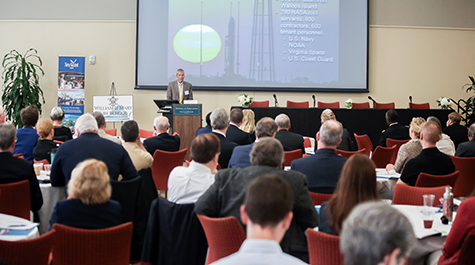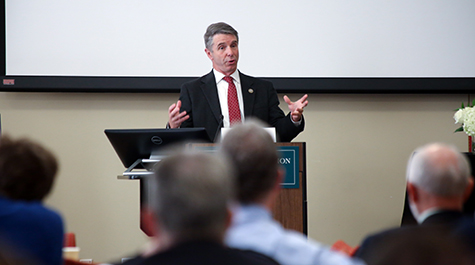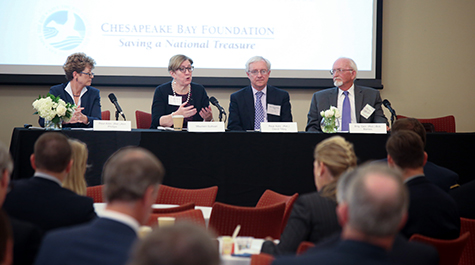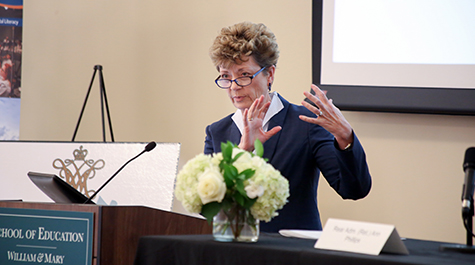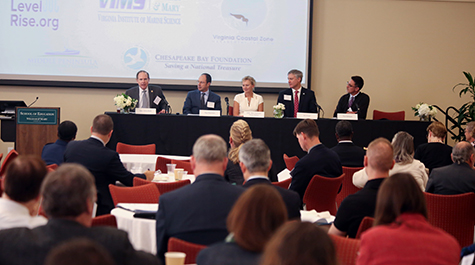Annual Coastal Policy Conference Addresses Problem of Rising Waters on Virginia’s Military Installations
“It’s kind of hard to take off if the tarmac has water on it.”
That was an observation of Congressman Rob Wittman (R-VA), Chairman of the House Armed Services Committee Seapower & Projection Forces Subcommittee, during William & Mary Law School’s Fifth Annual Virginia Coastal Policy Center Conference, “Defending Our Coasts: Ensuring Military Readiness and Economic Viability as Waters Rise.”
Held on Friday, Oct. 27, the day-long conference brought federal, state and local officials, and a large number of military leaders, to William & Mary to discuss ways of protecting Virginia’s military installations—and the entire Virginia coastline—from flooding.
Wittman’s tarmac comment referred to the increasing proclivity of water to rise and cover the runways at Langley Air Force Base in Hampton, Va.
“On average, about nine days a year, the base is affected by recurrent flooding,” Wittman said. “The same at Norfolk Naval facility where we have to make sure that sailors can get back and forth to their ships either for training or for deployment.”
With those problems always in focus, panelists and guest speakers discussed the threats that flooding poses to Department of Defense (DoD) facilities, DoD’s efforts to develop resilience measures, and the policy framework necessary to secure readiness.
Also discussed were challenges posed by recurrent flooding for local governments and the private sector, and collaborative solutions being implemented to address these challenges.
In his opening remarks, William & Mary President Taylor Reveley reinforced the effect of rising water on both the military and Virginia’s overall economy.
“William & Mary cares about the military; we also care very much about the health and welfare of Hampton Roads and the Commonwealth of Virginia as a whole,” Reveley said. “Failure to effectively defend the coast of Hampton Roads, if it led to the forced departure of the military bases located here, would be a severe blow to the economic and social fabric not just of Hampton Roads, but all of Virginia.”
Hosting the proceedings, Elizabeth Andrews, Director of William & Mary Law School’s Virginia Coastal Policy Center, felt that the subject of the conference was timely during a busy tropical storm season in the South Atlantic. She also mentioned that the conference was held two days before the fifth anniversary of Superstorm Sandy.
“That storm alone had damages estimated at $50 billion, and after that we had Harvey and Irma and Maria,” Andrews said. “All you have to do is think of the damage that was wrought in Houston, Puerto Rico, the Virgin Islands, and Florida to realize how timely this topic is.”
In order to deal with resilience, Andrews said Virginia needs to plan ahead for more than just tropical storms and hurricanes.
“We have the land sinking from subsidence, and we have the waters rising and we have extreme weather, and sometimes inadequate storm water systems,” Andrews said. “It takes planning ahead, it takes implementation authority, and it takes funding.”
Congressman Wittman went on to argue for a hand-in-hand approach between military bases and localities that employ resources to the maximum utility possible.
“There are opportunities to leverage private dollars with those of local, state and federal levels to do even more,” he said.
In addition to Wittman and Virginia Secretary of Natural Resources Molly Ward ’87 (who introduced Wittman), the event included several guest speakers: Dr. Jane Smith, Army Senior Research Scientist for Hydrodynamic Phenomenon; Curtis Brown, Virginia Deputy Secretary of Public Safety & Homeland Security; Col. Keith Morrow, U.S. Army (Ret.), Deputy Commander, 633rd Mission Support Group, Joint Base Langley-Eustis; William Wrobel, Director, NASA Goddard Space Flight Center, Wallops Flight Facility; and Carlos Hopkins, Virginia Secretary of Veterans and Defense Affairs.
Panels included: “The Current State of DoD Resilience Programs and What We've Learned” (Moderator: Col. Paul Olsen, P.E., U.S. Army Corps of Engineers [Ret.], Director, Programs and Partnerships, Old Dominion University, Research Office); “National Security and Policy Issues: What is Needed to Further Develop Resiliency Measures?” (Moderator: Rear Adm. Ann Phillips, U.S. Navy [Ret.]); “Opportunities Presented by Recurrent Flooding” (Moderator: The Honorable Chris Stolle, 83rd District, Virginia House of Delegates); and “Collaborative Solutions" (Moderator: Rear Adm. Craig Quigley, U.S. Navy [Ret.], Executive Director, Hampton Roads Military & Federal Facilities Alliance).
The conference unofficially began the previous evening at Williamsburg’s Kimball Theatre when the Coastal Policy Center hosted a screening of Tidewater: Water is Rising, Land is Sinking, but the Military is Here to Stay. The documentary was produced and directed by Roger Sorkin, and was introduced by Rear Admiral Ann Phillips (who appears in the movie). Mark Nevitt, Sharswood Fellow, University of Pennsylvania Law School, and Commander, U.S. Navy JAG Corps (Ret.), and The Honorable Monty Mason, Member of the Virginia Senate from the 1st District, also made remarks before the film.
The Fifth Annual Virginia Coastal Policy Center Conference was sponsored by Virginia Sea Grant, Virginia Environmental Endowment, Virginia Institute of Marine Science, Sealevelrise.org, the Virginia Coastal Zone Management Program, the Chesapeake Bay Foundation, and the Middle Peninsula Planning District Commission.
About William & Mary Law School
Thomas Jefferson founded William & Mary Law School in 1779 to train leaders for the new nation. Now in its third century, America's oldest law school continues its historic mission of educating citizen lawyers who are prepared both to lead and to serve.



